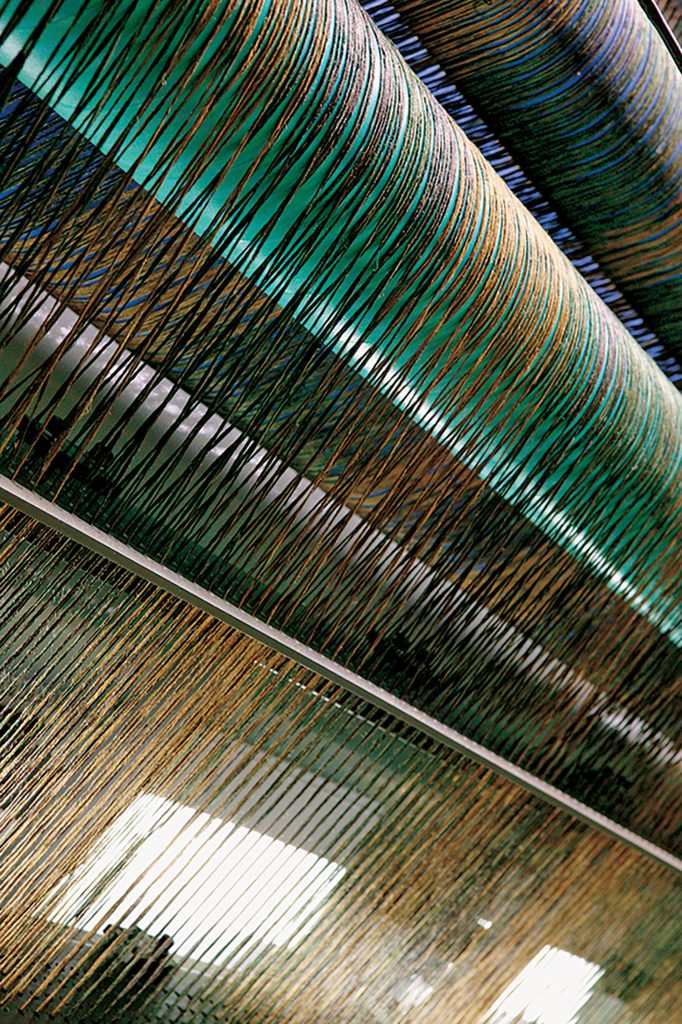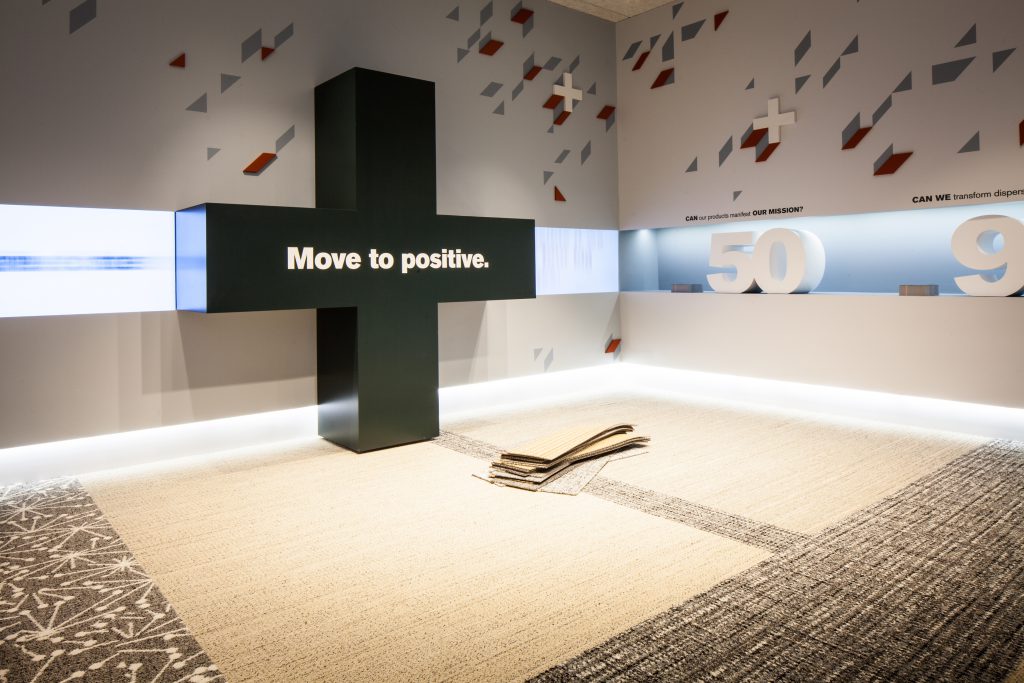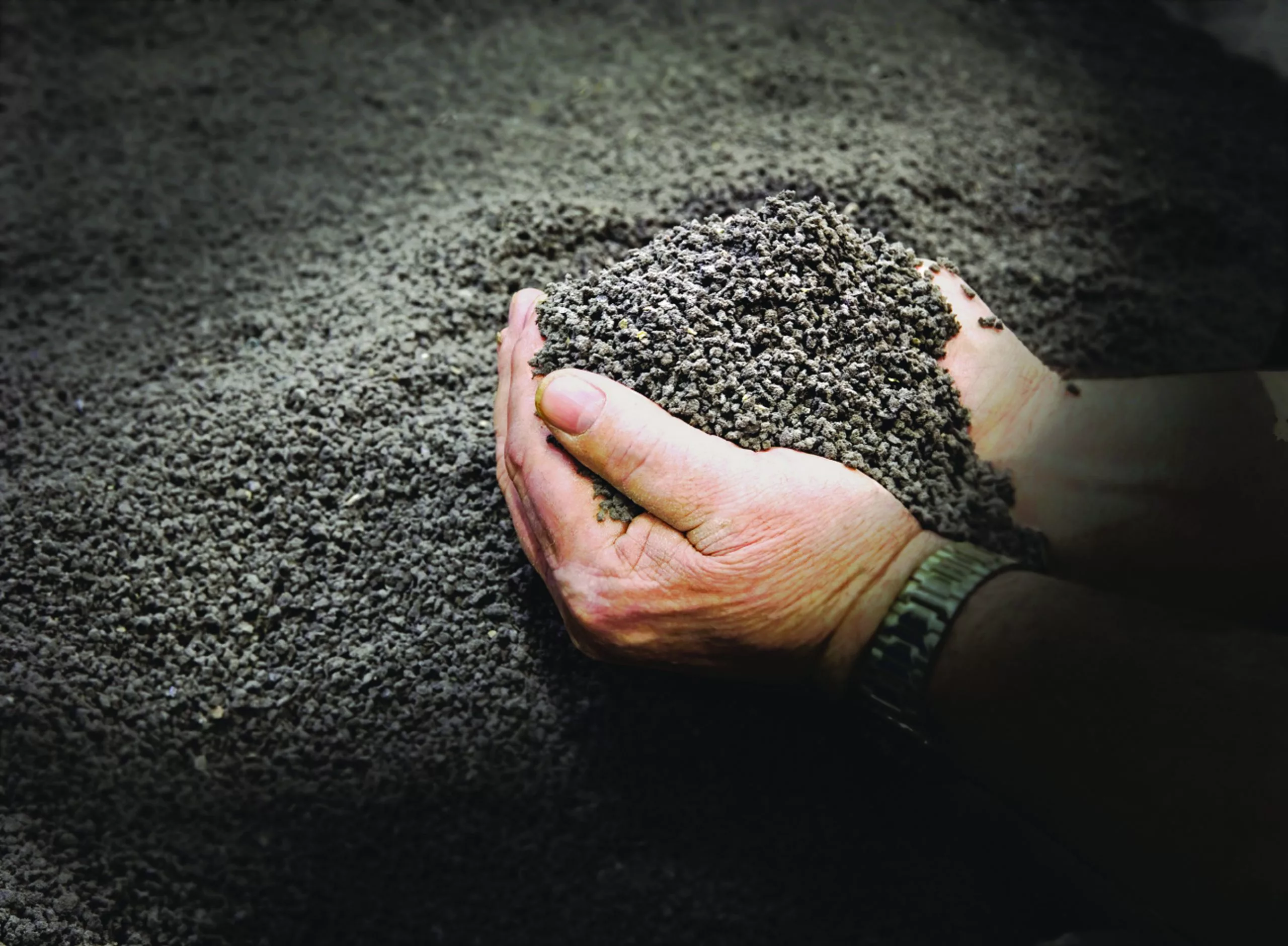Photos courtesy of Interface
I’m frequently surprised at how often I meet someone in the conscious business world who does not know about Interface. I can’t quite remember when I first heard about Ray Anderson’s 1994 spear-in-the-chest revelation and the 25-year environmental transformation that followed, but I have been a fan of the story for years: a global public company in one of the world’s dirtiest industries decides to become a paragon of environmental stewardship, embarking on “Mission Zero” — Interface’s promise to eliminate any negative impact the company may have on the environment by the year 2020 — not for marketing purposes, but because they can’t keep doing business as usual and be proud of the world they are leaving for their grandchildren.
Erin Meezan, chief sustainability officer and vice president of Interface Inc., also believes that the company’s story is important, and she admits that they could do a better job telling it. She sent me a copy of a speech she gave in January 2019 in which she summarized the company’s achievements to date:
- Interface has reduced waste to landfill 91%
- Interface has reduced factory water use 88%
- 88% of all the energy Interface uses globally comes from renewable sources, including 100% in Europe and 98% in the US
- All Interface factories operate with 100% renewable electricity
- Interface has reduced GHG emissions intensity 96%
“Because of our progress on recycled materials, we hit a major milestone in 2018,” Meezan says. “All of our products were able to be made carbon-neutral by purchasing a small amount of offsets. We now sell carbon-neutral products across our global portfolio, including carpet, rubber, and luxury vinyl tile — and we did that two years ahead of our commitment to do so by 2020. That means net-zero carbon in the atmosphere as a result of all of our products. Everywhere.”
There are many other conscious and environmentally sustainable companies out there, but most were born that way. It is rare indeed to find a story of corporate purpose transformation at a global scale. It is rarer still to find such a story in a public company. But the purposeful transformation of global public companies is exactly what the world needs now, and that is why the Interface story is so important. It has already inspired changes from visionary leaders like Richard Branson, founder of the Virgin Group, and Paul Polman, former CEO of Unilever, to name a few.
I believe a proper understanding of Interface’s story can not only inspire but also instruct us all in how a purposeless company can transform itself to become a vehicle for achieving something important for the world and improve its financial performance in the process. So last year, I began work on a feature documentary to tell the Interface story. In the process I have gotten to know the people who’ve spent their careers advancing “Mission Zero.” One of these people is Graham Scott, vice president of technical services of Interface.
Scott was brought into Interface long before the transformation started. I interviewed Scott in February, and he brought me a printed copy of a speech he had given. Like Meezan’s speech, it summed up progress to date, but the date of this one was the year 2000, just six years into the 25-year story, as Scott prepared to retire and leave the mission in the hands of the next generation. We asked Scott if we could share edited portions of his speech with Conscious Company readers. He agreed.
What follows here is a unique look at what was happening in the company in the early years of working toward achieving a monumentally bold vision. At this time, no one knew if they would be successful, and the kind of results Meezan shared last January were still 20 years away. The things Scott described in his speech are the building blocks of a corporate revolution. We would do well to study them so that we might better understand how to instigate similar revolutions in other global public companies.

From left: Graham Scott, Ray Anderson
Graham Scott // 2000 Speech
AWARENESS AND THE BEGINNING
One of Interface’s senior executives had called a meeting to consider environmental issues. He invited our CEO, Ray Anderson, to open the meeting and address the dozen or so executives in attendance. Ray frankly admitted that a day or so before, he had not known what he was going to say and was not certain why he had been asked to attend. Quite by chance, a few days earlier Ray had received a copy of Paul Hawken’s book “The Ecology of Commerce.” I think in desperation, Ray quickly read through the book in an attempt to have something to pass on. After reading it, Ray’s whole life changed in ways that he could not have foreseen, and as a result, the lives of many others would become changed for the better.
After Ray’s opening remarks, he presented us with a task that really got our stunned attention. He charged us with making Interface a sustainable enterprise: our company was to become an environmental leader. As the meeting progressed, we were each invited to share our thoughts. That’s when it hit me! By association I had consumed vast amounts of energy, materials, and resources; I had produced thousands of tons of product that would sit in landfills for hundreds if not thousands of years; I had polluted air and water in God-only-knows what quantities — and for what? The product I had made did little to improve humanity’s lot. You couldn’t eat it, learn from it, or claim that it had any lasting artistic value. I became very concerned over the extravagance that was my life. My remarks at that meeting reflected those thoughts. Others had similar thoughts and reactions.
Everyone likes to think their life has purpose. Was mine to destroy a supportive environment? What was my justification for being? When I came down to a basic answer, it was, of course, my family, children, and grandchildren. So in response to that responsibility I go and mess up their future by stealing resources from them and polluting their environment? Nice job!
BEING OVERWHELMED
So, where to start? Most of our products had proved the soundness of their design in years of use. Attempts by competitors to knock us off our perch were largely unsuccessful, especially if they tried to come up with product constructions that were radically different from ours. We had found that when we strayed from well-proven product systems, we always seemed to come up with an inferior result. So, changing from PVC, nylon, and fiberglass was, we felt, likely to put us out of business.
How about being more efficient and less wasteful? Any business that has stayed competitive over the years must surely be efficient, so there was not likely to be much there. Much of our equipment was up to date and not regarded as wasteful in any way, many of our factory buildings were reasonably new, and it was doubtful that much could be saved by investing in new premises. We enjoyed having as associates very capable engineers, planners, accountants, and production managers, together with a body of associates who were hardworking people. It was unlikely that we would be able to find any savings significant enough to make an environmental difference. The idea of being a sustainable enterprise seemed firmly out of reach.
Our CEO had told the US business community that we were going to be an environmental leader, and there we were wondering how, and silently hoping the whole thing would go away, even though we all knew in our hearts that it was the right thing to do.
Despite the enormity of the task confronting us, the seeds that would help us make a start had already been sown. It was one person who wrote the book that Ray read, it was one individual who called that first environmental meeting, and it was the commitment of one CEO who risked his reputation by standing in front of the business community to commit his company to the cause of sustainability. The power of the individual would be central to all of our efforts and would become the grassroots and the foundation upon which our journey towards sustainability would begin and grow. The power of one would be the key.
ONE STEP AT A TIME
A program came together that allowed every associate to promote ideas and suggestions to improve company performance. This program became known as QUEST: Quality Using Employee Suggestions and Teamwork.
Where we had thought that improvements were going to be hard to come by, we saw some very significant reductions in waste almost immediately. Ray at that time asked everyone to “brighten your individual corner.” In other words, try to do something no matter what. We all started to think about what we each might do to make a start, and the concept of us all taking individual small steps, each contributing to the whole, began to take hold.
After some initial cynicism by some senior executives, company management began to buy in and contribute to the program. We decided that if we were to enlist the efforts of every associate, then it would be necessary for everyone to understand what we were doing, why we were doing it, what we hoped to achieve, how we would manage and measure it, and how progress would be rewarded.
I am going to quote Ray’s stated position at that early point in our program: “I believe we have come to the threshold of the next industrial revolution. At Interface, we seek to become the first sustainable corporation in the world and, following that, the first restorative company. It means creating the technologies of the future — kinder, gentler technologies that emulate nature’s systems. I believe that’s where we will find the right model. Ultimately, I believe we must learn to depend solely on available income the way a forest does, not on our precious stores of natural capital. Linear practices must be replaced by cylindrical ones. That’s nature’s way. In nature there is no waste; one organism’s waste is another’s food.”

Interface’s products are all carbon neutral, meaning any emissions used to create the products that they have not yet been able to offset are negated by the purchase of carbon offsets.
ASSOCIATE EDUCATION, INVOLVEMENT, AND WELLBEING
We decided to give every single member of the Interface team an intensive three-day course that concentrated on bringing out the individuality of each attendee. Group activities demonstrated the power the individual has, especially when backed with the support and encouragement of a team of associates. Individuals found that they could, with the help of their workmates, achieve things that they never thought they were capable of.
We got people to understand the power of one and the strength of the individual both inside and outside a team. The three-day course and follow-up was a major step, and setting up QUEST teams throughout the organization provided a channel for ideas and suggestions for every individual in the company.
Biyearly meetings were attended by every employee. These meetings provided a venue where environmental issues would be discussed and accomplishments and individuals could be recognized for their contribution to our overall sustainability goals. Details of company policy were made known and plans for the future laid out. And at every meeting, Ray would reaffirm the company commitment to sustainability and would continue to teach and inform all of us about environmental issues. Today, training continues for all associates.
As the sustainability concept began to take hold, more and more associates began automatically thinking about the company’s stated environmental goals, and if a particular vendor was found to be thinking along sustainable lines, then Interface would work with that vendor rather than a competitor. This simple act, if everyone would follow it, would do so much to further the environmental cause.
EARLY FRUIT AND THE QUEST FOR IDEAS
Early on, we took a close look at what we were taking and how we were using it. We decided to measure both fuel and materials used in BTUs. Thus our gas, oil, and electricity consumption and our product construction materials were all reduced to the same unit of measurement, namely that of nonrenewable energy. How much could we immediately reduce our energy consumption? We found that a single pound of inbound unprocessed nylon represented about 65,000 BTUs of embodied energy and we discovered that a pound of backing material represented about 17,000 BTUs. This information would have recycling implications later. But for now we decided to concentrate on reducing our embodied energy consumption per square yard. A “Less is More” program was initiated.
Our recently developed testing equipment indicated that product construction had more of an effect on performance than the amount of material used. Well-designed 26-ounce products were found to outperform some 30-ounce materials. An extensive redesign of our entire product line followed. Over a period of 3 to 4 years, our average product pile weights were, by careful design and testing, reduced, yet at the same time product performance was increased. From this design and testing activity alone we removed 15,000 BTUs from our consumption for every square yard produced.
At the same time, we pushed for waste reduction in processing. Less trim waste, less planning waste, better production procedures, better use of energy, energy audits, electric motor sizing, insulation of premises, and so on. Our savings from embodied energy reductions and plant and process improvements were now approaching 25,000 BTUs for every yard of carpet produced. We were beginning our long journey towards sustainability.
But, after these first few steps had been taken and the low-hanging fruit picked, we seemed to be in danger of hitting a wall and not knowing where to go next.
QUEST set a new, self-driven goal: drive out waste, with an ultimate goal of zero waste. What’s the definition of waste? Anything that does not benefit our clients: materials that are used wastefully do not benefit clients; energy that is wasted does not benefit anyone, least of all our clients; customer-service mistakes will cause waste in materials, time, and energy; incorrectly designed machines and processes will be inefficient; products that are designed without considering their environmental impact will benefit no one; products designed without concern for the best possible performance per unit of material used will, in the long term, be wasteful; and so on. Slowly, our organization was finally becoming more responsive to environmental needs and, even more important, was becoming aware of the scale and size of the problem.
Many waste-reduction ideas came from the shop floor and from office workers who were in a position to understand what was needed to improve matters.
We set out to stop landfill usage by attacking the problem. Arrangements were made to either recycle old carpet into other products or to use it as a source of energy via clean-burning converters. Stringent requirements had to be met and satisfied before the energy conversion route was taken.
PROCEDURAL CHANGES
The normally accepted and industry-wide wear-test methods are conducted to reveal how much fiber is lost or how compressed a surface becomes. Most tests do not take into account the effects of soiling, nor do they consider the effects of floor maintenance. Typically a wear warranty will be written to take into account the amount of fiber lost in service, and, in a commercial installation, if more than 10 percent of fiber is lost, then a wear warranty is activated. Over a period of at least 25 years, I cannot recall one such complaint, yet we have had numerous situations where clients have been dissatisfied with the performance of their purchase, resulting in replacements being undertaken with the accompanying waste and loss of material. Clearly, something has been missing in our industry’s test procedures.
I decided that new test procedures were needed and set about developing more meaningful test equipment that would forecast what products would look like after periods of, say, 5 or 10 years of use. The resulting test procedure did not depend on “wear” as measured in a laboratory but instead examined the amount of appearance change that took place. As a result, we now look for constructions that resist appearance change. This automatically takes into account all of the factors that impact product performance. We refer to this approach as Appearance Retention Testing (ART). Our test considers the effects of traffic, soil, and maintenance. It also allows for different carpet-cleaning methods and will even factor in the modest maintenance budgets that exist in the real world.
During the extensive use of this newly developed equipment, we discovered that the density of a pile surface was a much bigger performance factor than pile weight or content. This discovery directly supported our “Less is More” philosophy.
ART identified a way for our product designers to reduce pile content and at the same time increase product performance and lengthen service life. Our product designers embraced this method and, as a matter of course, now test all prototypes before investing in any new product line. Product performance complaints decreased, with accompanying drops in material and energy losses. Additionally, customer expectations are now measured and accommodated by testing and showing ahead of time how the product they are considering for purchase will perform in their location. This allows them to select the best product for their particular use, further helps reduce product performance complaints, and gives our customers confidence in the purchase they are about to make.
ART testing has played a significant role in the reduction of BTUs needed to produce our product lines and incidentally prevented the introduction of newly developed nylon fiber that would not have performed in the commercial environment in which we operate — thus avoiding unnecessary waste.
This test-procedural change came about because we believed in the power of the individual and were allowed and encouraged to develop out-of-the-box ideas and procedures. On a personal note, I felt like I had been given a chance to start to give something back after many years of being an environmental taker, and I must confess to regarding the project as something akin to a crusade on my part.
Imagine, then, the commitment it takes for a company to create the conditions necessary to allow individuals to take risks without fear of reprisal and to take those steps that contribute to the overall goals of the crusade.

Recycled-content nylon on a tufter.
PRODUCT DESIGN CHANGES
There is a growing movement within the environmental activist framework that believes there are many answers regarding sustainable development to be found by studying nature itself. Interface is very fortunate to have the services of an imaginative designer who continually thinks out of the box. For years we have been challenged to hide carpet tile joints to make the installed material look like broadloom without seams. For all sorts of reasons, this is very difficult to achieve. Also, it is necessary for the same reason to install carpet tiles all in the same direction because if you don’t, individual tiles will stand out like a sore thumb. Our designer got his idea from the bed of a natural stream of water. What he observed was thousands of pebbles on the stream’s bottom, each one different in shape and color, and yet no matter where he looked, the overall effect of the composite of all the stones was the same no matter how they were arranged. By careful use of color placement and by randomizing a pattern, he designed a product line in which no two carpet tiles would ever be alike, yet each contained the same colors. The results were amazing. These particular tiles can be installed without regard to direction, and the overall effect is a stunning seamless broadloom. Nature was waiting in the wings all along with a solution to the problem. We are in the process of taking this random concept further in the hope that we will be able to mix old with new and therefore get a second life from used product when it comes time for replacement.
This experience has encouraged a closer look at nature. What if we could duplicate the strength of a silkworm’s thread? Some shell creatures have developed materials of incredible strength and have done so in natural, gentle, environmentally friendly conditions. Nature uses life-friendly manufacturing processes and self-assembly; incredibly smart when you think about it. What can we learn from all this? Are there lessons for industrialists to heed or perhaps ignore at their peril? I suspect that nature will teach us much if we will only heed her.
CLOSING
So that is our scorecard after six years of effort: about a 25 percent reduction in nonrenewable materials consumption; reductions in global warming potential, emissions, water, and landfill usage; increased renewable energy production; and recycled content in our product lines. We have an evolving and steadily improving ecometric accounting system that is showing us what we need to do and tells us that we must now concentrate on reducing carbon content in our product lines. Obviously we have a long way to go, but we are on our way. I don’t believe we could have come this far without having a dedicated environmentalist at the helm. The reality is that the sustainability journey is not an easy one. Companies have to find ways to stay in business whilst at the same time turning their efforts towards sustainability. Interface has, as a result of its journey towards sustainability, been able to reduce product cost and manufacturing costs. These savings have helped offset all the training and development costs. These reductions would not have been accomplished without the support of our entire workforce.
We are looking for a groundswell of environmental responsiveness from our client base. There are signs that it is beginning to happen and when it does, and when clients are prepared to make buying decisions that factor in environmental concerns, Interface will be ready and will prosper. Doing well by doing good will then be seen by others to be the way to go, and we hope our business model will become the norm for more and more enterprises.

This installation was created to symbolize Interface’s Climate Take Back mission: to move toward positive impact and reverse global warming.
Almost 20 years after Scott gave these remarks, Meezan reported the results that opened this article. And in that speech, she also announced the next chapter of the Interface story: “Climate Take Back.” Stay tuned.
Conscious Company readers can hear more about Climate Take Back directly from Erin Meezan in our August Live Q&A.





